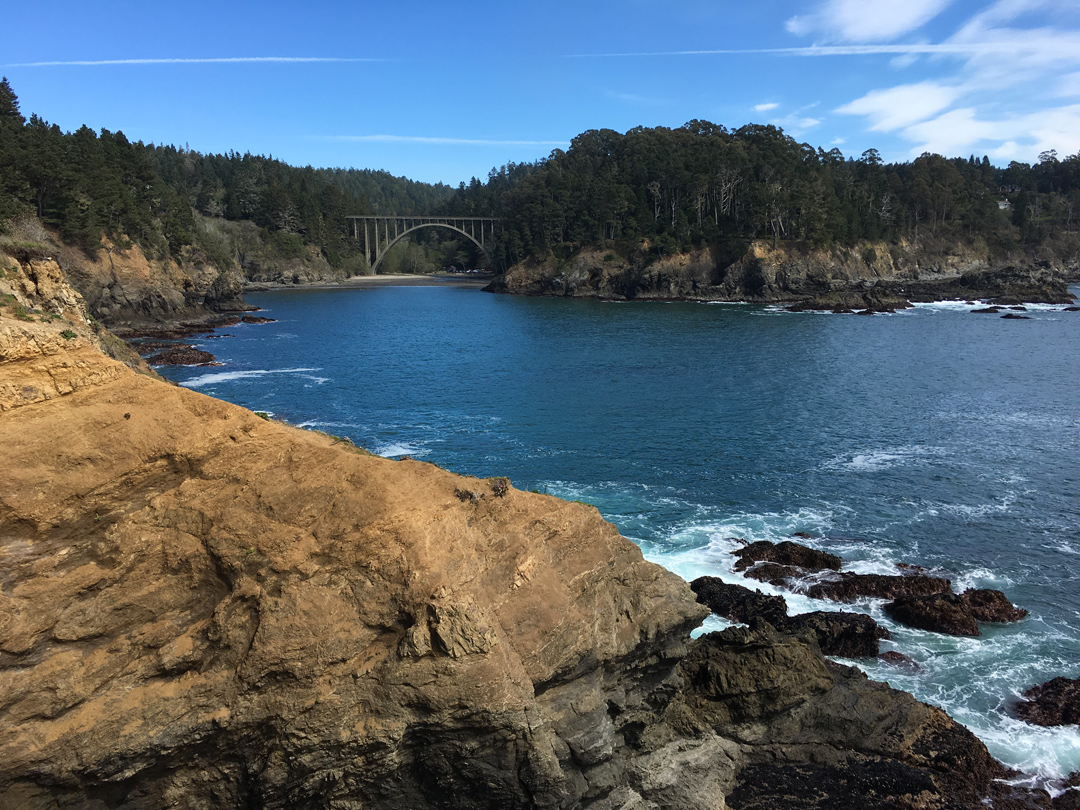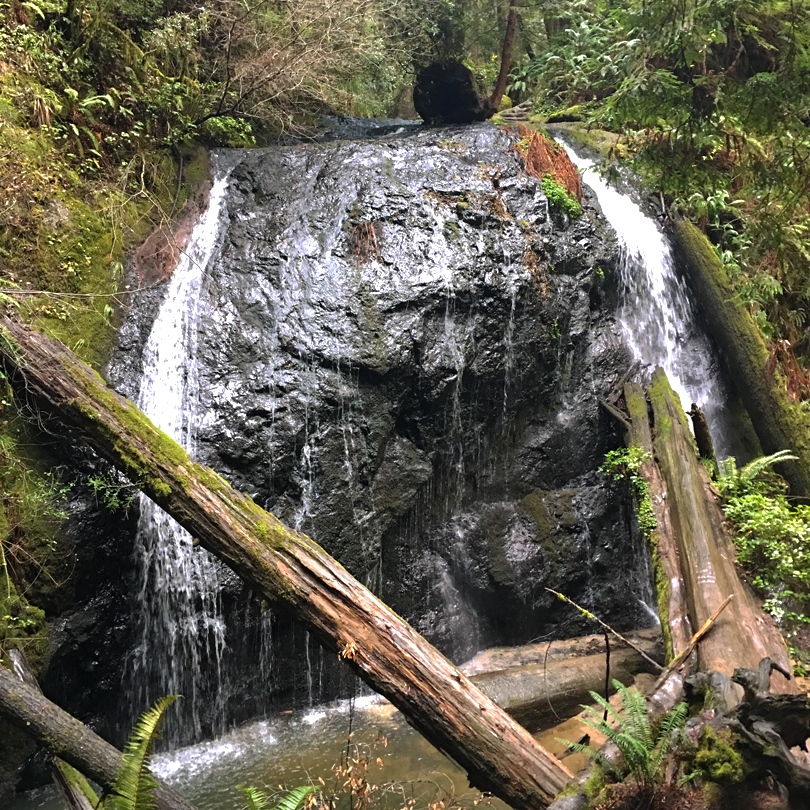
photo by C. Shen
Imagine a place along the California coast where redwood trees and ferns stand peacefully, securely rooted in the soil. Beneath the adjacent turquoise waters, kelp and other seaweeds are firmly attached to the rocky seabed, swaying and swirling with the churning of the ocean. A visit to Russian Gulch State Marine Conservation Area (SMCA) and Russian Gulch State Park, located just two miles north of the charming coastal town of Mendocino, brings this vision to life.

CDFW Marine Region map
Among California’s statewide network of 124 marine protected areas (MPAs), 35 are located next to a State Park. While the California Department of Fish and Wildlife (CDFW) is the lead management agency for the MPA Network, the California Department of Parks and Recreation (State Parks) is a co-manager. California MPAs limit fishing and other forms of natural resource take, but coastal access and general recreation are encouraged at most MPAs. In some MPAs, like Russian Gulch SMCA, recreational fishing is allowed. This balance between promoting both conservation and public recreation makes for a natural partnership between CDFW and State Parks.
A small MPA has existed at Russian Gulch since 1970 as part of the State Park, but in 1999 the Marine Life Protection Act directed the state to redesign its existing MPAs into a more comprehensive and cohesive network. The new Russian Gulch SMCA was established in 2012, along with 19 other north coast MPAs. Although it remains small compared to other MPAs, covering only about one quarter square mile, its area has nearly tripled from its previous size. The regulations for Russian Gulch SMCA allow both recreational and commercial take, consistent with historical regulations. As only commercial take of bull kelp and giant kelp is prohibited, it is one of the least restrictive MPAs in California’s MPA Network.
Kelp forests are one of the key habitats that California’s MPAs aim to protect. They are a vital feature of California’s coastal seascape and form the foundation of a rich community of fish, invertebrates, and marine mammals. Kelp forests help regulate the environment in a way that is beneficial to humans by taking up carbon dioxide, a greenhouse gas, and moderating wave energy, which reduces coastal erosion.


The calmer waters maintained by kelp forests also creates excellent conditions for diving and kayaking. Unfortunately, in recent years, kelp forests have declined by over 90 percent along the northern California coast, caused by a “perfect storm” of events linked to climate change. Although MPAs are intended to reduce human impacts on marine ecosystems, they can’t be the only solution. This year, the state has launched the Kelp Recovery Research Program to jumpstart kelp restoration efforts.
While large decreases in kelp are a recent trend at Russian Gulch SMCA, another iconic marine species has been absent from Russian Gulch SMCA for two centuries. Southern sea otters once thrived in the dense kelp forests lining these shores. Their abundance drew the interest of early Russian explorers, who may have been the first non-Native people to arrive in the area, giving Russian Gulch its name. Russians sailed down to California from Alaska to expand the fur trade in the early 1800s, and in 1812, the southernmost Russian settlement in North America was established at Fort Ross, about 75 miles south of Russian Gulch.
If you have ever touched a sea otter pelt, it is easy to understand why they were so highly valued. Sea otters have the densest fur of any mammal, as they don’t have blubber to help keep warm like other marine mammals. They were so heavily exploited that in the span of just a few short years, their populations were decimated.
After being hunted nearly to extinction, a colony of 50 to 150 sea otters was spotted by the public in 1938 off the remote coast at Big Sur. Their number has now grown to around 3,000 animals. Although they have not made it back to Russian Gulch SMCA or any other part of the north coast, sea otters are a common sight along the central coast, including at Elkhorn Slough SMCA in Moss Landing, Edward F. Ricketts SMCA and Lovers Point-Julia Platt State Marine Reserve (SMR) in Monterey, Point Lobos SMR in Carmel, and Morro Bay State Marine Recreational Management Area.
Despite the absence of sea otters at Russian Gulch SMCA, there is still plenty to see and do in the area. A picturesque concrete arch bridge named after state bridge engineer, Frederick W. Panhorst, spans Russian Gulch Creek on Highway 1 and serves as a prominent landmark for the State Park and SMCA. Under the bridge, a sandy beach lies at the mouth of Russian Gulch Creek and provides a gateway to the SMCA. Popular water activities include swimming, diving, kayaking, tidepooling, and ocean fishing (fishing is not permitted in the creek). Be mindful that the ocean in this area is very cold and the waves and currents can be dangerous. Devil’s Punchbowl, a sea cave eroded by wave action and collapsed into a sinkhole, is a clear example of Russian Gulch SMCA’s turbulent setting. Always check local ocean conditions before entering the water.
If you prefer to admire the ocean from the safety of land, Russian Gulch State Park offers two short headland trails, one north and one south of the bridge, for breathtaking views and ceaseless photo opportunities. The headland trail north of the bridge features Devil’s Punchbowl, where you can marvel at the ocean’s relentless surge and listen to its roiling echo. Lush trails leading inland up Russian Gulch Creek meet with a scenic 36-foot waterfall, best viewed in winter and spring. Camping is available in the park, and more accommodation options can be found nearby in the quaint town of Mendocino or the larger city of Fort Bragg. Please check park closures and local ordinances regarding COVID-19 before planning a visit.
Situated along northern California’s sparsely populated coast, it is hard to imagine a more scenic place than Russian Gulch. With the State Park trails, a beach, a campground and an SMCA that does not restrict recreational take, there are plenty of options for you to decide how to enjoy your visit. While you are there taking in the magnificent coastal views, set aside a moment to imagine what Russian Gulch looked like in the past, and how you would like for it to look in the future.
Russian Gulch State Marine Conservation Area is one of the 124 MPAs in California’s statewide MPA Network. Please visit CDFW’s MPA website for more information, and sign up to receive updates about the MPA Management Program.
post by Chenchen Shen, CDFW Environmental Scientist
Learn more about MPAs by diving into the
Exploring California’s Marine Protected Areas series!










